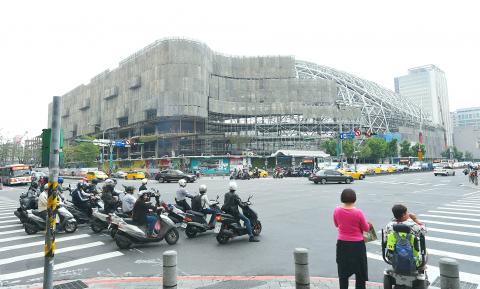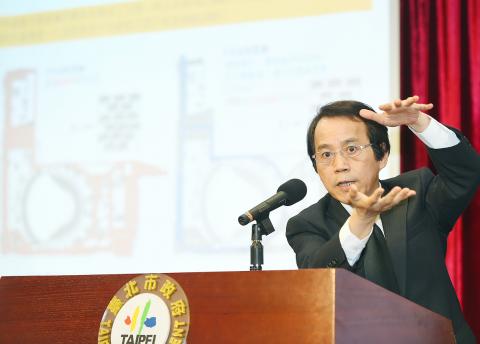Either the Taipei Dome (台北大巨蛋) or its neighboring shopping mall should be demolished, Taipei Deputy Mayor Charles Lin (林欽榮) said yesterday, as he presented the results of the city’s safety inspection commission into the Dome’s evacuation plans.
Computer analysis of the evacuation plans found that the construction of a large shopping mall adjoining the Dome would prevent the site from being evacuated within 15 minutes.
In addition to increasing the difficulty of evacuating the Dome itself, the city’s computer model found that the shopping mall would be difficult to evacuate, with exits remaining clogged a full hour after an evacuation began.

Photo: Chang Chia-ming, Taipei Times
Lin attributed the results to overbuilding on the construction site by contractor Farglory Land Development Co (遠雄建設), with the area occupied by buildings increasing from 46 percent in the initial plan put forward in 2004 to 54.5 percent at present.
“An area equal to five Sogos has been added to the complex,” Lin said, referring to the Taipei Pacific Sogo Department Store (太平洋崇光百貨) shopping mall. “Excessive additional building space has caused the Taipei Sports and Cultural Park to become highly dangerous and a potential disaster area.”
He said that the city’s analysis found that the open space surrounding the Dome complex could only hold 60,000 people, far fewer than the estimated 140,000 people who could be inside the buildings during an emergency.

Photo courtesy of the Taipei City Government
He added that the lack of space would also prevent fire trucks from attending a disaster at the site.
“The site design would crowd everyone onto [neighboring] Guangfu S Road and Zhongxiao E Road,” Lin said. “In that event, how can rescue operations be conducted?”
Lin said that while the city “respected” the Ministry of the Interior Construction and Planning Agency’s approval of site safety plans, it questioned whether a truly rigorous analysis had been conducted, given the lack of clear national standards for evaluating a structure as large as the Taipei Dome.

Photo: Chang Chia-ming, Taipei Times
He said Farglory had failed to conduct a comprehensive analysis of evacuation procedures for the entire complex, while setting an unrealistic evacuation objective of having all of the spectators out of their seats within eight minutes in a “preliminary” evacuation, compared with the 15-minute complete evacuation standard used in Japan.
Lin said that Farglory also incorporated other numerous problematic assumptions into their model, including failing to take into consideration the obstacle Dome seating would present to fleeing spectators.
He said the firm made an unrealistic calculation of how quickly fleeing spectators would be able to escape the structure and also inflated the amount of “open space” around the structure by incorporating stairways and failing to subtract space which would be needed for rescue operations.
While Farglory’s analysis only involves an “ordinary” evacuation, the city conducted an “emergency” analysis, he said.
Lin also cited the ease with which a fire could spread throughout the complex as a major concern, calling the two stories of parking beneath the site which connects the different buildings “unprecedented.”
A fire within the parking lot would be extremely difficult to reach and extinguish, while it could easily spread throughout the complex, he said.
Given the safety problems unearthed, the commission recommended that either the Dome itself or the neighboring mall should be demolished to provide more open space for an emergency evacuation, he said, adding that the site’s underground parking should also be sealed off.
The complex’s other buildings would be unaffected.
Lin declined to comment on the effect the city’s report would have on ongoing negotiations with Farglory, adding that the negotiations were the responsibility of a separate committee headed by Deputy Mayor Teng Chia-chi (鄧家基).
Teng refused to respond to reporters’ questions, instead releasing a statement saying that as long as there were public safety concerns the city would not allow the complex to begin operations.
The Taipei City Government launched a safety investigation into the Dome after Farglory refused to agree to demands for concessions during a renegotiation of the terms of the contract.
The Taipei Department of Sports said that the Taipei Gymnasium could serve as the main site for the 2017 Universiade if the Taipei Dome is unavailable.

The CIA has a message for Chinese government officials worried about their place in Chinese President Xi Jinping’s (習近平) government: Come work with us. The agency released two Mandarin-language videos on social media on Thursday inviting disgruntled officials to contact the CIA. The recruitment videos posted on YouTube and X racked up more than 5 million views combined in their first day. The outreach comes as CIA Director John Ratcliffe has vowed to boost the agency’s use of intelligence from human sources and its focus on China, which has recently targeted US officials with its own espionage operations. The videos are “aimed at

STEADFAST FRIEND: The bills encourage increased Taiwan-US engagement and address China’s distortion of UN Resolution 2758 to isolate Taiwan internationally The Presidential Office yesterday thanked the US House of Representatives for unanimously passing two Taiwan-related bills highlighting its solid support for Taiwan’s democracy and global participation, and for deepening bilateral relations. One of the bills, the Taiwan Assurance Implementation Act, requires the US Department of State to periodically review its guidelines for engagement with Taiwan, and report to the US Congress on the guidelines and plans to lift self-imposed limitations on US-Taiwan engagement. The other bill is the Taiwan International Solidarity Act, which clarifies that UN Resolution 2758 does not address the issue of the representation of Taiwan or its people in

US Indo-Pacific Commander Admiral Samuel Paparo on Friday expressed concern over the rate at which China is diversifying its military exercises, the Financial Times (FT) reported on Saturday. “The rates of change on the depth and breadth of their exercises is the one non-linear effect that I’ve seen in the last year that wakes me up at night or keeps me up at night,” Paparo was quoted by FT as saying while attending the annual Sedona Forum at the McCain Institute in Arizona. Paparo also expressed concern over the speed with which China was expanding its military. While the US

SHIFT: Taiwan’s better-than-expected first-quarter GDP and signs of weakness in the US have driven global capital back to emerging markets, the central bank head said The central bank yesterday blamed market speculation for the steep rise in the local currency, and urged exporters and financial institutions to stay calm and stop panic sell-offs to avoid hurting their own profitability. The nation’s top monetary policymaker said that it would step in, if necessary, to maintain order and stability in the foreign exchange market. The remarks came as the NT dollar yesterday closed up NT$0.919 to NT$30.145 against the US dollar in Taipei trading, after rising as high as NT$29.59 in intraday trading. The local currency has surged 5.85 percent against the greenback over the past two sessions, central